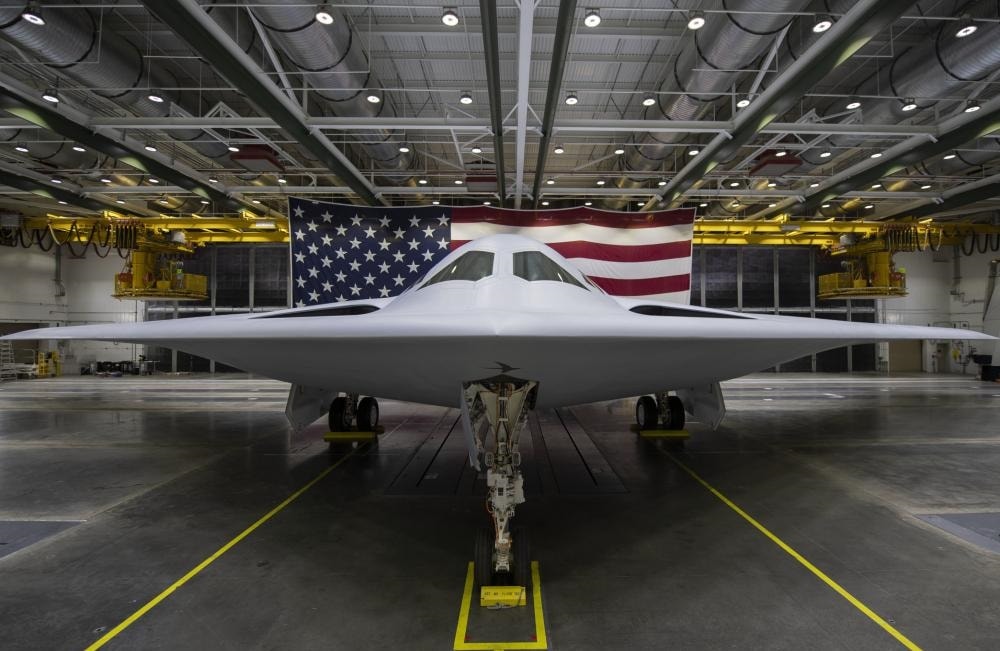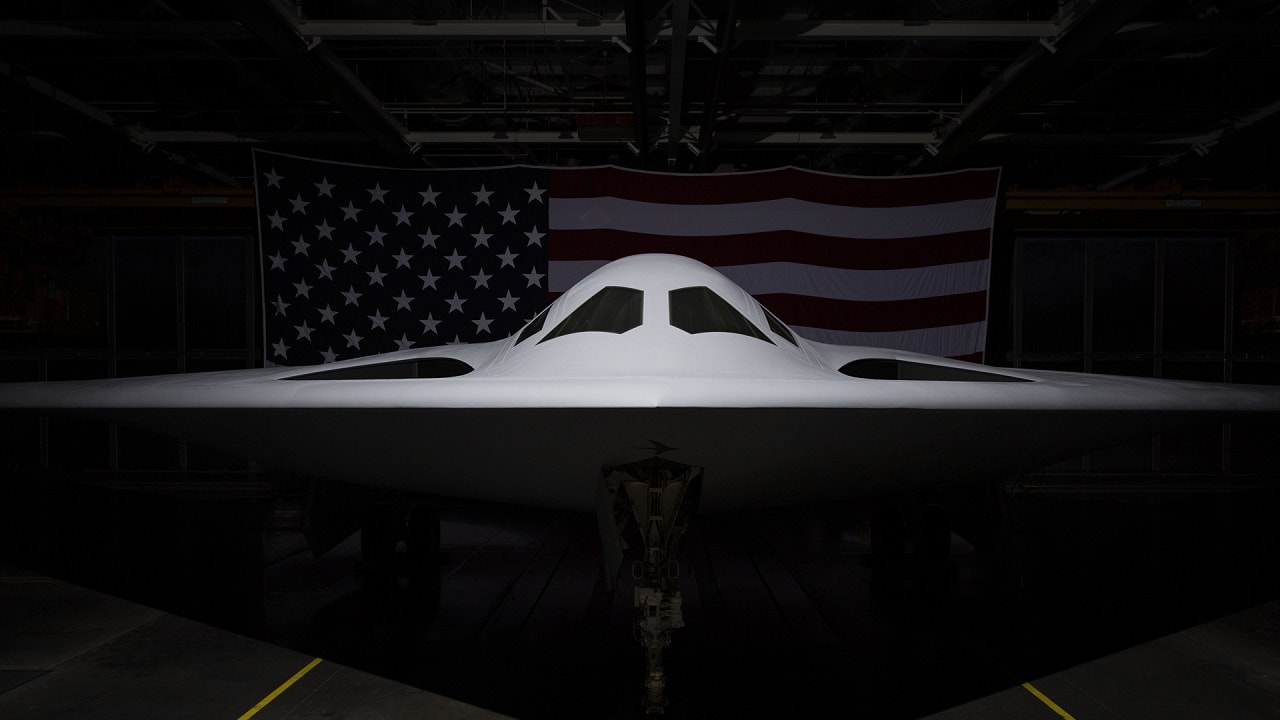Editor’s Note: The following is a new installment of our ongoing B-21 Raider stealth bomber series by Philip Handleman. You can read the other parts of the series here.
In Afghanistan from October 2001 through August 2021, the U.S. confronted a primitive enemy while fostering and then continuously bolstering a disproportionately large indigenous force. By all accounts, this was a numerically and technologically lopsided war. During those 20 years, the U.S. and its Western allies funneled enormous human and material resources into the fight, employing some of the most advanced weapons the world has ever seen.
Included in the mix were constellations of high-tech satellites providing valuable battlefield support from secure communications to highly accurate navigation coordinates, precision-guided cruise missiles fired from nuclear-powered submarines, squadrons of cutting-edge drones prowling the skies with spot-on targeting capabilities, and yes, stealth bombers unleashing ordnance on long-distance missions.
Despite not having a single satellite, cruise missile, or crewed aircraft, let alone a stealth bomber, Taliban members exhibited a strong will to fight. The insurgents used Kalashnikovs, rocket-propelled grenade launchers, improvised explosive devices, and suicide vests to outlast the better-trained and equipped forces arrayed against them, sending the U.S. packing. The fiasco culminated in a helter-skelter evacuation eerily reminiscent of the tumultuous and humiliating American withdrawal from Vietnam a generation before.
The tragedy of Afghanistan has had far-reaching consequences. Less than six months after the evacuation’s last C-17 transport plane soared into Kabul’s darkened sky, leaving behind an unsettled Hindu Kush, Vladimir Putin’s forces unleashed a full-scale assault on Ukraine. Subsequently, the Russian leader has fixated on what he refers to as a decadent Western culture in decline. He has received varying degrees of support for his war of choice from other leading autocrats – the Iranian mullahs, Kim Jung-un of North Korea, and China’s Xi Jinping. Also buoyed by events in Afghanistan, Xi soon began to ramp up provocations against Taiwan, heightening speculation that an invasion may be in the offing.
With the benefit of hindsight, it has become increasingly obvious that the collective sigh of relief that stemmed from the Iron Curtain’s collapse was premature. The once all-consuming Cold War did not totally dissolve. Instead, it morphed. No longer neatly defined as between two clearly formed visions – Leninist Communism, on the one hand, and Jeffersonian Democracy, on the other hand – the ideological clash now pits various brands of authoritarianism against a consensus anchored by convictions of independence, self-determination and the rule of law.
Perceiving the West as flaccid and headed towards implosion, today’s strongmen flout their disregard for the norms of civil society and cynically perpetrate chaos and violence as a means to realizing their domination agenda. A unifying factor for these tyrants, who include such dissimilar figures as post-Soviet revanchist and Islamist hegemons, is a shared interest in tearing down the beacons that would shed light where their darkness reigns.
The post-World War II international world order has never been more threatened and, alarmingly, no corner of the globe is immune. Conflicts appearing to be localized or regional, like those involving Ukraine, Israel, and South Korea, really represent the frontlines in the larger battle between the expansionists who rule with a dark vision backed by an iron fist and the constitutionalists who treasure freedom born of trust in the popular will.
Ceding any of today’s beacons of light to the loosely-knit cabal of bullying martinets, whether through pallid support for freedom’s besieged defenders or desperate negotiation with duplicitous rogues, can hardly help but draw analogies to the disastrous 1938 Munich Agreement that fed Czechoslovakia to Hitler’s Germany on the faulty premise that appeasement would bring peace. Dictators respect only strength and when they detect weakness they become emboldened, plowing ahead to devour the next victim.
And, as the experience in Afghanistan demonstrates, it is possible to employ wonder weapons against an enemy equipped with merely a second-rate arsenal, yet still fall short of the end goal. In the history of war, sometimes superior equipment and greater numbers are enough to win and other times intangibles like the combatants’ motivation supersede the material edge. Regardless, possessing qualitative and quantitative advantages is invariably preferable. Simply put, warfighting is harder without it.
The B-21 Raider is calculated to be a superior weapon for its user nation. Of course, how the bomber will perform in combat is not knowable until forces engage. For now, it is the best that American industry can offer. Delivering it on a faster track and in greater numbers than what has been publicly discussed to date would push the edge of the security envelope to provide a greater margin.
One way to grow the number of B-21s is to offer the bomber and its family of systems to reliable allies and partners, something that was not done with the B-2 or the F-22 but that is being done with the F-35. Sharing advanced weapons among like-minded governments spreads the cost burden, enhances deterrence, and strengthens Western militaries’ critical mass.
As widely reported, Australia is a leading candidate to buy or lease the B-21. An increasingly pugnacious China has been heightening security concerns of the Indo-Pacific democracies for some time. In mid-September 2021, Australia entered the AUKUS (Australia-United Kingdom-United States) deal that calls for the U.S. and the U.K. to share nuclear submarine technology with their new partner. The pact implicitly recognizes the special nature of defending Australian sovereignty in the region’s vast open waters.
In a show of support for the trilateral deal, President Joe Biden met with Australian Prime Minister Anthony Albanese and U.K. Prime Minister Rishi Sunak at the Point Loma naval base in southern California on March 13, 2023. Under the terms of the multi-phase plan announced by the leaders, Australia will send its sailors to train with their American and British counterparts, will host nuclear submarines from the two partner nations, purchase up to five American Virginia-class nuclear-powered submarines and ultimately build its own nuclear-powered (but not nuclear-armed) submarines based on its partners’ technology. Against this backdrop, the B-21 would seem a logical addition to Australia’s military.
Indeed, Air Marshal Robert Chipman, Chief of the Royal Australian Air Force, who attended the new bomber’s rollout on December 2, 2022, expressed his enthusiasm for the B-21 program afterward, stating on Twitter that the ceremony was “an awesome display of U.S. innovation and industrial might.” Australian Defense Minister Richard Marles echoed the sentiment, describing the B-21 as “very cool looking.”
A December 2022 analysis by Marcus Hellyer and Andrew Nicholls of the Australian Strategic Policy Institute weighed what the authors describe as “the gold standard in strike capability” against the high costs, asserting that the Australian government should be open to a purchase of perhaps a 12-aircraft B-21 squadron, subject to the receipt of more information from the U.S. For now, though, U.S. Defense Secretary Lloyd Austin wants the focus to be on getting the B-21 “tested and fully outfitted.”
If Australia desires to move forward and if the U.S. is willing to oblige, the program could very well become the paradigm for how other Western powers would go about acquiring (or leasing) and operating small numbers of the B-21 and associated systems. With the bombers and their collaborative drones widely dispersed in mini-clusters at geostrategic locales around the globe, the U.S. would have, in effect, a surrogate strike force augmenting its own. The expanded presence of such weapons might give pause to adversaries contemplating hostile action against democratic neighbors and, in any case, complicate their warfare modeling.
It should be recalled that in the 1950s the U.K. fielded an indigenously developed long-range strategic bomber force for the purpose of standing guard against the Soviet Union and, if the Cold War turned hot, delivering nuclear weapons. The so-called V-bombers were a mix of three types – the Vickers Valiant, the Avro Vulcan, and the Handley Page Victor. Altogether, more than 300 were produced.
By the late 1960s, the V-bombers that remained in service with the Royal Air Force were considered vulnerable to Soviet air defenses and responsibility for the nuclear deterrence role shifted to the U.K.’s submarine force. Vulcans remained active and even delivered conventional bombs during the Falklands War in 1982 while the Victors were converted into aerial refuelers in which role they continued until being retired in 1993. Surviving examples of the V-bombers are now museum pieces, but they symbolize an era when, as an American ally, the U.K. went the extra mile in shouldering part of the burden of protecting the international world order.
Integrating B-21s into the RAF would represent the service’s return to operating strategic bombers after a long hiatus. Even if the U.K. government decided not to equip its B-21s with nuclear weapons, the RAF’s contingent of heavy bombers would show a renewed commitment to the defense of the West that just might reboot the region’s strategic balance.
If other industrialized nations closely allied with the U.S. in Europe, Asia, and the Middle East become B-21 operators as well, it is possible that as many as 50 to 75 additional Raiders could go on flight status, increasing the total deployable force by 50 percent or more over the minimum of 100 aircraft that the U.S. Air Force intends to buy.
However, as mentioned earlier, there needs to be a diverse bomber force with new and different platforms introduced and fielded more rapidly – certainly on timelines shorter than the all too familiar three-plus decades. Otherwise, the military aviation enterprise will be subject to stagnation and enemies will use the extended voids between new developments to figure out how to exploit chinks in the armor.

During the Cold War, Strategic Air Command held America’s nemesis in check. Now as a new assortment of nefarious actors threatens to suffocate democracy, the buildup of superior forces is imperative for the free world. Sharing the B-21 with allied nations’ air forces would enlarge the bomber fleet and constitute a 21st-century variation of the unparalleled American air power behemoth of the past.
Expert Biography and Expertise
Philip Handleman is a pilot and aviation author/photographer. With retired Air Force Lt. Col. Harry T. Stewart, Jr., he cowrote Soaring to Glory: A Tuskegee Airman’s Firsthand Account of World War II. Mr. Handleman’s photograph of the Air Force Thunderbirds was featured on the postage stamp honoring the 50th anniversary of the Department of the Air Force in 1997.

